Force-sensing and signaling logic of cells
More to come.
Amplification of oncogenes on extrachromosomal DNA in cancer cells
 Oncogene activation is a key mechanism that drives cancer. We discovered a novel mechanism by which tumor-driving oncogenes amplified outside chromosomes, termed extrachromosomal DNA (ecDNA), can be activated by clustering with one another in cancer cells. ecDNA clustering was associated with active oncogene transcription. Inhibition of bromodomain proteins, chromatin readers which bind to acetylated histones, dispersed ecDNA hubs and reduced oncogene transcription. We proposed that ecDNA hubs may be protein-mediated oncogene clusters that allow cross-activation between molecules and intermolecular interactions between non-coding regulatory elements.
Oncogene activation is a key mechanism that drives cancer. We discovered a novel mechanism by which tumor-driving oncogenes amplified outside chromosomes, termed extrachromosomal DNA (ecDNA), can be activated by clustering with one another in cancer cells. ecDNA clustering was associated with active oncogene transcription. Inhibition of bromodomain proteins, chromatin readers which bind to acetylated histones, dispersed ecDNA hubs and reduced oncogene transcription. We proposed that ecDNA hubs may be protein-mediated oncogene clusters that allow cross-activation between molecules and intermolecular interactions between non-coding regulatory elements.
To analyze their genetic sequences and epigenetic features, we demonstrated a method for isolating ecDNA from cancer cells called CRISPR-CATCH. We identified a number of unique mutations on ecDNA, displaying strong genetic divergence from native chromosomes and selection of activating oncogene mutations. DNA methylation analysis using nanopore sequencing following CRISPR-CATCH revealed hypomethylation of the oncogene promoter on ecDNAs, suggesting decreased DNA methylation as another potential mechanism of oncogene upregulation on ecDNAs. Finally, we developed a computational workflow for reconstruction of ecDNAs, leading to the discovery of specialized ecDNA structures with rearranged oncogene sequences and enhancer elements.
Together, this work demonstrated how formation of circular ecDNA structures in the cancer genome can lead to dysregulation of oncogene expression with implications of how these alterations may affect cancer cell fitness.
Key Publications:
Hung KL et al. Nature 2021
Hung KL et al. Nature Structural & Molecular Biology 2022
Hung KL et al. Nature Genetics 2022 (research briefing)
Hung KL et al. Nature 2024
Manipulating immune cell differentiation via cytokine stimulation and genome editing
 We developed a workflow for engineering primary human B cells to express therapeutic proteins. Using an ex vivo multi-step culturing strategy, we were able to differentiate engineered cells into plasma cells and engraft them into mice to stably secrete exogenous proteins into peripheral blood. As plasma cells can be long-lived (decades!), we used this proof-of-concept study to demonstrate that engineered B cells have the potential to be a new form of long-term protein therapy.
We developed a workflow for engineering primary human B cells to express therapeutic proteins. Using an ex vivo multi-step culturing strategy, we were able to differentiate engineered cells into plasma cells and engraft them into mice to stably secrete exogenous proteins into peripheral blood. As plasma cells can be long-lived (decades!), we used this proof-of-concept study to demonstrate that engineered B cells have the potential to be a new form of long-term protein therapy.
Key Publications:
Hung KL et al. Molecular Therapy 2018
Cheng RYH, Hung KL et al. Nature Communications 2022